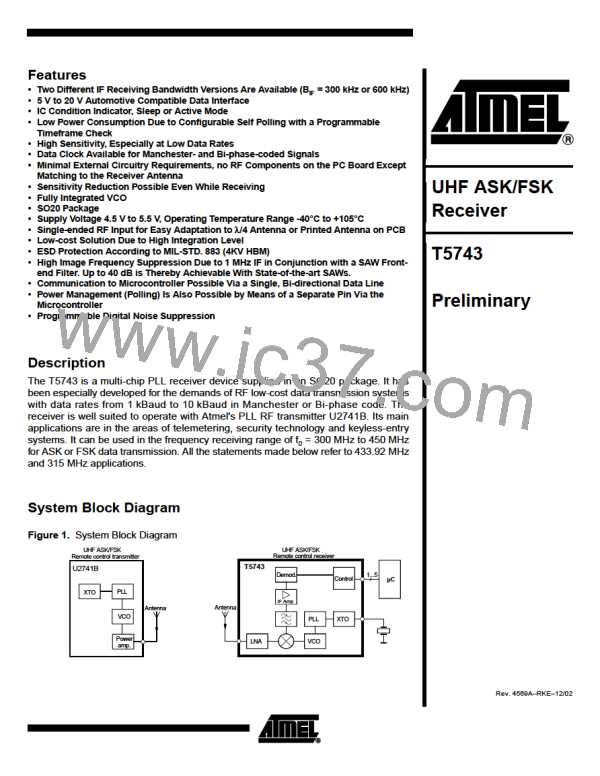T5743
Figure 11. Timing Diagram for Complete Successful Bit Check
( Number of checked Bits: 3 )
Bit check ok
IC_ACTIVE
Bit check
1/2 Bit
1/2 Bit
1/2 Bit
1/2 Bit
1/2 Bit
1/2 Bit
Dem_out
Data_out (DATA)
TStart-up
TBit-check
Start-up mode
Bit-check mode
Receiving mode
Bit-check Mode
In bit-check mode the incoming data stream is examined to distinguish between a valid
signal from a corresponding transmitter and signals due to noise. This is done by subse-
quent time frame checks where the distances between two signal edges are
continuously compared to a programmable time window. The maximum count of this
edge-to-edge tests before the receiver switches to receiving mode is also
programmable.
Configuring the Bit Check
Assuming a modulation scheme that contains two edges per bit, two time frame checks
are verifying one bit. This is valid for Manchester, Bi-phase and most other modulation
schemes. The maximum count of bits to be checked can be set to 0, 3, 6 or 9 bits via the
variable NBit-check in the OPMODE register. This implies 0, 6, 12 and 18 edge to edge
checks respectively. If NBit-check is set to a higher value, the receiver is less likely to
switch to receiving mode due to noise. In the presence of a valid transmitter signal, the
bit check takes less time if NBit–check is set to a lower value. In polling mode, the bit-check
time is not dependent on NBit-check. Figure 11 shows an example where 3 bits are tested
successfully and the data signal is transferred to Pin DATA.
According to Figure 12, the time window for the bit check is defined by two separate
time limits. If the edge-to-edge time tee is in between the lower bit-check limit TLim_min and
the upper bit-check limit TLim_max, the check will be continued. If tee is smaller than
T
Lim_min or tee exceeds TLim_max, the bit check will be terminated and the receiver
switches to sleep mode.
Figure 12. Valid Time Window for Bit Check
1/fSig
tee
Dem_out
T
Lim_min
T
Lim_max
For best noise immunity it is recommended to use a low span between TLim_min and
Lim_max. This is achieved using a fixed frequency at a 50% duty cycle for the transmitter
T
preburst. A “11111...” or a “10101...” sequence in Manchester or Bi-phase is a good
choice concerning that advice. A good compromise between receiver sensitivity and
susceptibility to noise is a time window of ±25% regarding the expected edge-to-edge
time tee. Using pre-burst patterns that contain various edge-to-edge time periods, the
bit-check limits must be programmed according to the required span.
The bit-check limits are determined by means of the formula below.
13
4569A–RKE–12/02

 ATMEL [ ATMEL ]
ATMEL [ ATMEL ]